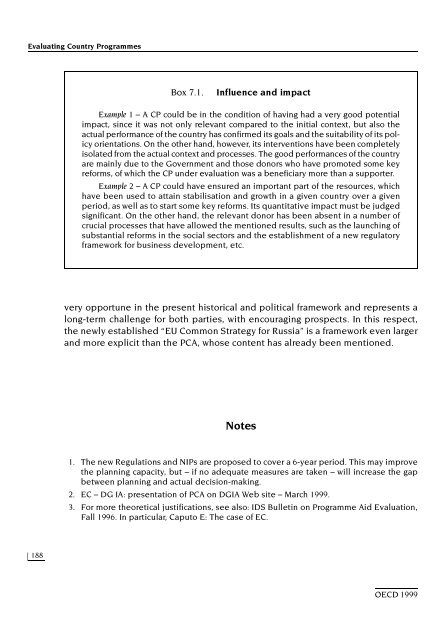Evaluating Country Programmes - OECD Online Bookshop
Evaluating Country Programmes - OECD Online Bookshop
Evaluating Country Programmes - OECD Online Bookshop
You also want an ePaper? Increase the reach of your titles
YUMPU automatically turns print PDFs into web optimized ePapers that Google loves.
<strong>Evaluating</strong> <strong>Country</strong> <strong>Programmes</strong><br />
188<br />
Box 7.1. Influence and impact<br />
Example 1 – A CP could be in the condition of having had a very good potential<br />
impact, since it was not only relevant compared to the initial context, but also the<br />
actual performance of the country has confirmed its goals and the suitability of its policy<br />
orientations. On the other hand, however, its interventions have been completely<br />
isolated from the actual context and processes. The good performances of the country<br />
are mainly due to the Government and those donors who have promoted some key<br />
reforms, of which the CP under evaluation was a beneficiary more than a supporter.<br />
Example 2 – A CP could have ensured an important part of the resources, which<br />
have been used to attain stabilisation and growth in a given country over a given<br />
period, as well as to start some key reforms. Its quantitative impact must be judged<br />
significant. On the other hand, the relevant donor has been absent in a number of<br />
crucial processes that have allowed the mentioned results, such as the launching of<br />
substantial reforms in the social sectors and the establishment of a new regulatory<br />
framework for business development, etc.<br />
very opportune in the present historical and political framework and represents a<br />
long-term challenge for both parties, with encouraging prospects. In this respect,<br />
the newly established “EU Common Strategy for Russia” is a framework even larger<br />
and more explicit than the PCA, whose content has already been mentioned.<br />
Notes<br />
1. The new Regulations and NIPs are proposed to cover a 6-year period. This may improve<br />
the planning capacity, but – if no adequate measures are taken – will increase the gap<br />
between planning and actual decision-making.<br />
2. EC – DG IA: presentation of PCA on DGIA Web site – March 1999.<br />
3. For more theoretical justifications, see also: IDS Bulletin on Programme Aid Evaluation,<br />
Fall 1996. In particular, Caputo E: The case of EC.<br />
<strong>OECD</strong> 1999

















![CQE=U]^\]Z: KAZAKHSTAN - OECD Online Bookshop](https://img.yumpu.com/3915768/1/190x253/cqeuz-kazakhstan-oecd-online-bookshop.jpg?quality=85)